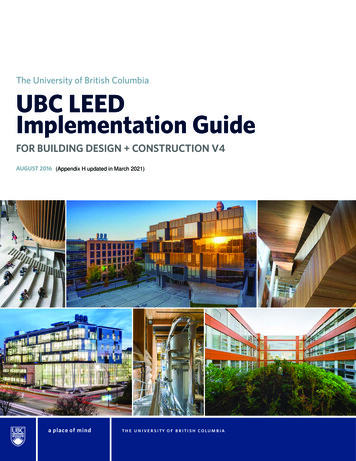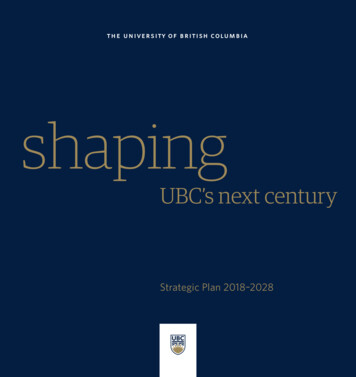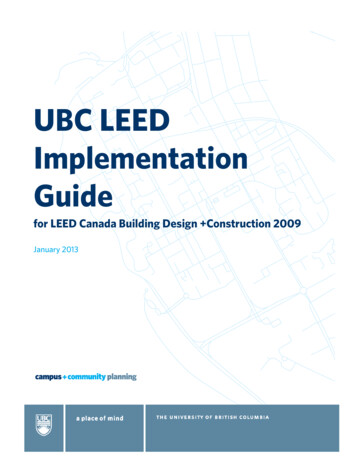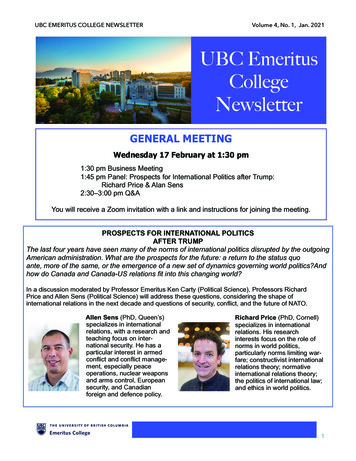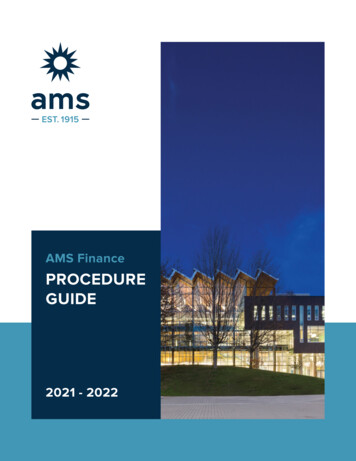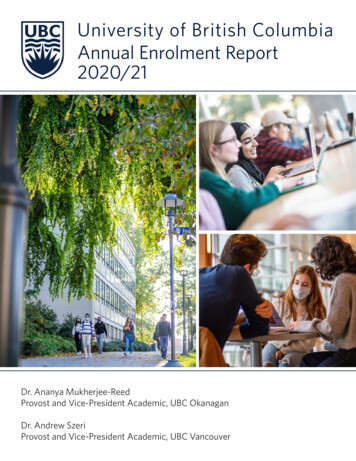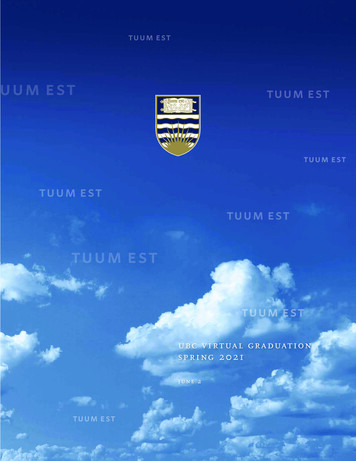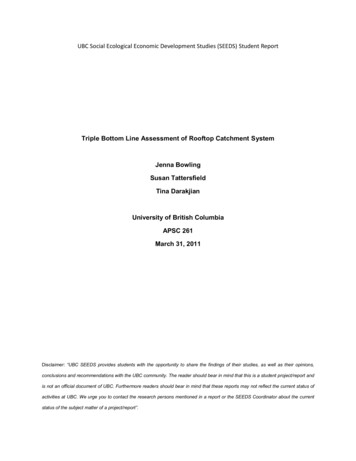
Transcription
UBC Social Ecological Economic Development Studies (SEEDS) Student ReportTriple Bottom Line Assessment of Rooftop Catchment SystemJenna BowlingSusan TattersfieldTina DarakjianUniversity of British ColumbiaAPSC 261March 31, 2011Disclaimer: “UBC SEEDS provides students with the opportunity to share the findings of their studies, as well as their opinions,conclusions and recommendations with the UBC community. The reader should bear in mind that this is a student project/report andis not an official document of UBC. Furthermore readers should bear in mind that these reports may not reflect the current status ofactivities at UBC. We urge you to contact the research persons mentioned in a report or the SEEDS Coordinator about the currentstatus of the subject matter of a project/report”.
TRIPLE BOTTOM LINE ASSESSMENT OF ROOFTOP CATCHMENT SYSTEMSubmitted to Dr. Dawn MillsBy Jenna Bowling, Susan Tattersfield, Tina DarakjianSource: Ubyssey, 2011, sets-the-stage-for-new-subs-theatre University of British ColumbiaApplied Science 261March 31 20111
ABSTRACT“Triple Bottom Line Assessment of Rooftop Catchment System”By Jenna Bowling, Susan Tattersfield, Tina DarakjianThe University of British Columbia (UBC) plans to implement a rainwater harvestingsystem atop the roof of the new student union building (SUB). An investigation into the rooftopdesign and potential catchment materials was carried out to determine the associatedeconomic, environmental and social impacts. A material analysis for the water supply anddrainage piping is also considered. A low sloping roof design is chosen for its ability to preventexcessive loading due to factors such as ponding of rainwater.The four potential roofing types studied for a low slope roof design were asphalt,concrete, green roof, and aluminum. Overall, concrete roofing was deemed most appropriatedue to its superior economic and environmental implications. Although green roof is seen asthe more socially viable option, its adverse economic and environmental implications are toogreat to base the roof design solely on appearance. Cast iron piping for the drainage systemappeared most advantageous when compared with acrylonitrile butadiene styrene (ABS) for itslong design life and recyclability. It is also considered more economically and environmentallysound over the lifetime of the SUB building. Polypropylene pipes are recommended for thewater supply piping as they are most cost effective, and strongly support Leadership in Energyand Environmental Design (LEED) initiatives. Lastly, the optimal material for the gutter system,an intermediary of the rooftop and piping systems, is galvanized steel. This is proposed as aresult of its long life span and ability to resist corrosion.2
TABLE OF CONTENTSABSTRACT .iiLIST OF FIGURES . . . viLIST OF TABLES. . .viiGLOSSARY . . viiiLIST OF ABBREVIATIONS ix1.0 INTRODUCTION . .12.0 ROOFTOP CATCHMENT DESIGN . . .22.1 Projected Rainfall Accumulation . . .22.2 Hazards in Potential Loading . .32.2.1 Climatic Loading Variables for the Greater Vancouver Area . .32.2.2 Water Ponding . .42.2.3 Catchment Design . .43.0 ECONOMIC MATERIAL ANALYSIS: ROOFING . .63.1 Asphalt . . . .63.2 Concrete . . . . .63.3 Aluminum . . 73.4 Green Roof .74.0 ECONOMIC MATERIAL ANALYSIS: PIPE AND GUTTER SYSTEMS . .84.1 Drainage Piping. . . . 83
4.1.1 Cast Iron . 84.1.2 ABS . .94.2 Water Supply Piping . .94.2.1 Copper . 94.2.2 Polypropylene .104.3 Gutter System . . . . . .104.3.1 Aluminum versus Galvanized Steel . 105.0 ENVIRONMENTAL MATERIAL ANALYSIS: ROOFING . .125.1 Concrete . . . .125.2 Asphalt . . . . .135.3 Aluminum . 133.4 Green Roof . .146.0 ENVIRONMENTAL MATERIAL ANALYSIS: PIPE AND GUTTER SYSTEMS .156.1 Drainage Piping. . . . . 156.1.1 Cast Iron . 156.1.2 ABS .156.2 Water Supply Piping . . .166.2.1 Polypropylene 166.2.2 Copper . . .166.3 Gutter System . . . . . .184
6.3.1 Aluminum versus Galvanized Steel . 187.0 SOCIAL IMPLICATIONS OF ROOFING, GUTTER, PIPING MATERIALS. .197.1 Roofing Materials . .197.1.1 Asphalt .197.1.2 Aluminum . 197.1.3 Concrete .197.1.4 Green Roof 207.2 Gutter Materials . . . .207.2.1 Galvanized Steel . .207.2.2 Aluminum . 207.3 Piping Materials . . 217.3.1 Cast Iron . .217.3.2 ABS .217.3.3 Copper . .217.3.4 Polypropylene . 218.0 CONCLUSION . . . .22REFERENCES . . . 235
LIST OF FIGURESFigure 1. Annual rainfall accumulation as determined by Google Earth Software . .2Figure 2. Free Body Diagram of Deflection of Roofing Material due to Water Ponding . .4Figure 3. Four Possible Orientations of Catchment Slope . . .5Figure 4. Average pH Chart. . .13Figure 5. Green Roof . 14Figure 6. Emissions in Air . . . .17Figure 7. Emissions in Water .17Figure 8. Emissions in Soil . . .17Figure 9. Energy Equivalent Value . . . .186
LIST OF TABLESTable 1. Maximum Loads due to Wind, Rain, and Snow .3Table 2. Comparative Material Cost Analysis . .7Table 3. Comparative Material Cost Analysis: Pipes . .10Table 4. Comparative Material Cost Analysis: Gutter System .117
GLOSSARYGalvanizeAdd layers of zinc to protect from corrosionGalvanic AnodesThe main component of a system used to protect buried or submergedmetal structures from corrosionBitumenNaturally occurring impure mixtures of hydrocarbonsCisternThe tank in which the collected rainwater is being storedBiofilmAn aggregate of microorganisms in which cells adhere to each otherand/or to a surfaceCarcinogenic CompoundsAgents directly involved in cancerDisinfected ByproductsWater Pollutants8
LIST OF ABBREVIATIONSUBCUniversity of British ColumbiaSUBStudent Union BuildingABSAcrylonitrile Butadiene StyreneSEEDSSocial, Ecological, Economic, Development StudiesFBDFree Body DiagramPAHPolycyclic Aromatic HydrocarbonsSCMSupplementary Concrete MaterialsUSGBCUnited States Green Building CouncilCSACanadian Standards AssociationLEEDLeadership in Energy and Environmental Design1.0 INTRODUCTIONThe roof catchment atop the new SUB is proposed to span 2719m 2, which isapproximately half the total projected roof area. The scope of this project includes acomparison of various roof designs and materials, along with the gutter and piping systems. Asit is primarily a flat roof, a few simple designs to reduce extensive loading are discussed. Ananalysis of several possible roofing materials is conducted including asphalt, concrete, greenroof, and aluminum. The advantages and disadvantages of galvanized steel and aluminum9
gutter systems are assessed. There are two separate piping systems which will be in place, onewhich carries water from the rooftop into the cistern where the water will be stored, and onewhich carries the water out of the cistern and to into the new building. Upon consideringpossibilities for building materials we will explore their long-term economic, environmental andsocial repercussions. This provides a basis for a triple bottom line assessment and will allow foroptimal material choice in order to successfully meet LEED standards for the New SUB.2.0 ROOFTOP CATCHMENT DESIGNA simple rooftop design is suggested to minimize rooftop loading due to wind, rain and snow.2.1 PROJECTED RAINFALL ACCUMULATIONTo determine the net rainwater accumulated per annum Google Earth software was utilised.The region highlighted in red (Figure 1) represents the catchment area of the new Student UnionBuilding. The building below the shaded zone is the existing SUB.10
Figure 1: Annual rainfall accumulation as determined by Google Earth Software.Google Earth uses satellite data and precipitation records collected by the Government of Canada toestimate the net annual accumulation into this region. The program provided an estimate of a total of1300mm of rainwater to collect in this catchment zone over an average year, which is equivalent to36525450 litres of water.To provide a more practical understanding of this very large volume, the problem wasinterpreted as the total number of possible toilet flushes. If the average toilet uses about 6 litres ofwater per use then the total number of possible flushes can be calculated as:36525450litres 6087575 flushes from one year of rainwater harvest6litres / flushThese numbers are quite substantial and provide evidence that there is excellent opportunity inexploitation of rainwater resources for the New SUB catchment zone.2.2 HAZARDS IN POTENTIAL LOADINGA simple catchment design is proposed to reduce loading as well as maximize rainfall potential.11
2.2.1 CLIMATIC LOADING VARIABLES FOR THE GREATER VANCOUVER AREAThe new SUB catchment must be designed to withstand the following loading factors forVancouver’s climate and hydrology (Table 1):WINDMaximum loads of 0.48 kPaRAINA maximum of 124mm (0.2 kpa) accumulationwithin a 24 hour periodSNOWMaximum loads of 1.9kPaTable 1: Maximum loads due to wind, rain and snowNote: the above values are quoted from the SUB 75% Schematic Design GuidelinesFrom the data provided in the table above it can be concluded that the strength of the roofingmaterial must be able to withstand a maximum load of 1.9kPa. Although snow provides a greatermaximum instantaneous impact on the roof structure, rainfall is a prominent climate feature and willtherefore be the most consistent forcing mechanism. The minimum temperatures are rarely abovefreezing and rainfall occurs almost constantly throughout the seasons. However, the annual averagetemperatures remain above zero degrees Celsius (Environment Canada). Although rainfall appliessmaller instantaneous loads than both snow and wind, the duration of loading is much longer. For thisreason, rainwater is the most critical loading factor for the design and structural integrity of the rooftopof the New SUB. The average wind speed is also quite constant as Vancouver is sheltered by coastalmountain ranges.Overall, snow loads create the greatest maximum loads of all three climatic mechanisms. It may,however, be noted that periods of sub zero temperatures are very uncommon compared to idealconditions for rainfall accumulation.2.2.2 WATER PONDINGWater ponding is caused by concentrated snow and rainwater loads which act to deform thestructural integrity of flat roofs. This has the potential to prevent the catchment area from effectivelytransmitting flows into the gutter system. A free body diagram of this occurrence is provided in Figure 2below. The deflection in the centermost part of the catchment volume (V) is a function of the total12
length and net applied loads (Blaauwendraad, 2007). Potential designs to reduce the possible adverseeffects associated with such loads on a flat roof may be found in section 2.2.3 below.Figure 2: Free Body Diagram of deflection of roofing material due to water ponding.2.2.3 CATCHMENT DESIGNThe optimal catchment design for the New SUB reduces the possible adverse effects associatedwith rain and snow loads, while increasing the rainwater catchment potential. Orientations A, B, C and D(Figure 3) illustrate four different structural options frequently used in rooftop design. The triangularregion above each profile represents the net loading shadow imposed on the catchment surface. Thesedistributions have been determined using an equilibrium relationship of various force vectors acting onthe 2D plane. For the flat roof (A), a uniform and horizontal load results, while B, C and D carry atriangular loading pattern. Option B clearly has the smallest loading area, thus it is the most effectivedesign for minimising the applied load.The implementation of a sloped roof appears to be optimal, however if the roof is too steep itwill increase the water velocity and may lead to possible overflow and potential loss of collectedrainwater. Thus, option B oriented between 10-30 degrees is the most ideal orientation for careful flowinto the gutters and finally to the underground cistern.13
Figure 3: Four possible orientations of catchment slope.3.0 ECONOMIC MATERIAL ANALYSIS: ROOFINGThis section encompasses a breakdown of several roofing materials, distinctive materialproperties and their initial costs, along with their expected lifespan. The total cost of materials is basedon the 100 year expected design life of the New SUB, thus it includes the cost of all replacements14
needed. Through further investigations beyond the scope of this report it can be determined that extraexpenses due to maintenance are consistent for all roofing materials except green roofs.3.1 ASPHALTAsphalt is generally used to describe asphalt concrete, a combination of bitumen and aconglomeration of various minerals (Trumbore et al., 2005). This type of roofing is best suited for colderweather climates due to its dark colour and ability to absorb heat. A comparative cost analysis is shownin Table 2 below. The expected lifetime of asphalt is 20-30 years, leading to extra expenses associatedwith the need for multiple replacements. Although it appears to be the most economically viable option,further social and environmental analysis will prove it inadvisable.3.2 CONCRETEConcrete is the most resistant of all materials and has been proven to last for long periods oftime in many roofing applications. There are no anticipated replacement expenses if concrete is used asthe rooftop of the New SUB. As well, there are little to no related maintenance costs as it does not rustor burn. Concrete is generally an impermeable material, dependent primarily on the grain size of theaggregate used (Hoseini, Bindiganavile, & Banthia, 2009). If exposed to extensive chemical ormechanical weathering, the design life may be greatly reduced. Due to Vancouver’s milder climate thereis low risk of these adverse processes such as freeze thaw weathering. As it is a fairly heavy material,initial transportation costs may be high. This may be easily balanced by the lack of replacementsneeded. With a minimal total cost of 29 900, it is the recommended rooftop material from a wellinformed economic standpoint. As there is extensive loading associated with this roof type, thisrecommendation is highly dependent on the structural materials chosen for the entire New SUB, and isbased on the proposed 75% schematic design.3.3 ALUMINUMAluminum roofing is highly resistant to corrosion and is a very lightweight yet durable materialused in many roofing applications. This material also has the unique ability to reflect light in the summerseason, which will help keep the New SUB building cool (Alvarado & Martínez, 2008). Aluminum roofs,15
however, are significantly more prone to the occurrence of damage and deformation. The installationprocess may be quite costly as further insulation would be needed to prevent excessive noise due toweather. It is difficult to find many, if any, commercial roofing applications which use aluminum for largeareas of flat roof. As a result of its high initial cost, and potential need for extensive maintenance,aluminum is not the economically favourable material for the rooftop catchment of the New SUB.3.4 GREEN ROOFA green roof is undoubtedly the most environmentally friendly and socially pleasant roofingmaterial on the market. However its use as a roofing material for rainwater catchment systems is still awidely debated topic (Czemiel Berndtsson, 2010). A green roof consists of a vegetated rooftop surfacewith an impermeable layer below. With the initial cost of a green roof at 25.00 per square foot, it is themost expensive material included in this analysis. This cost includes the addition of the abovementioned impermeable layer needed. The green roof is the only option requiring maintenance on aweekly basis, adding an additional yearly cost of 30000 dollars. This type of roofing has a design life ofaround 40 years as the base layer deteriorates (Carter & Keeler, 2008). From an economic standpoint, itwould be near impossible to balance the economic implications with the environmental and socialbenefits arising from such a materialTABLE 2: COMPARATIVE MATERIAL COST ANALYSISCost per ft2InitialLifetimeReplacementsReplacementTotal Cost( )Cost ( )(Years)NeededCost ( )( )Asphalt0.86230020-304920011 500Concrete11.00 m329 9001000029 900Aluminum9.5025 80040 125 80051 600Green Roof25.0067 90040 167 900135 800ProductTable 2 shows a comparative cost analysis of the initial and replacement costs for all four roofingmaterials over the catchment area (2719 m2). Transportation costs are not included as they are oftennegated due to the general trend of heavier materials having a much longer design life.4.0 ECONOMIC MATERIAL ANALYSIS: PIPE AND GUTTER SYSTEMS16
A general analysis of the materials to be used for both the piping and gutters systems for thecatchment of rainwater was executed, along with a cost analysis. A material lifetime and expensesummary can be found in Table 3 below.4.1 DRAINAGE PIPINGDrainage piping consists of the pipes exiting the underground cistern, and may be composed ofeither cast Iron or ABS (Acrylonitrile Butadiene Styrene). The pipes will most likely be locatedunderground and thus subject to external loading.4.1.1 CAST IRONCast Iron is most commonly seen in older model buildings, such as those built in the 19thcentury, and is often replaced today by ductile iron pipe which is very similar in composition (Bilgin &Stewart, 2009). The greatest benefit is its long service life, as it is expected to last from 75 to 100 yearsproviding that a few measures are taken in order to prevent corrosion. Corrosion occurs because ofphysical and chemical weathering, and may be reduced by methods of coating or casing the pipes or bygalvanic anodes (Cenoz, 2010). The price of cast iron piping quoted at 9.60 per foot with a four inchdiameter includes protection against corrosion. The long life of this material is largely due to the factthat its strength is not compromised by time. Cast iron has a low value for thermal expansion, allowingfor little to no deformation under an applied load and only breaks down through weathering orcorrosion. As fewer joints are needed to allow for expansion due to decreased deformation, the costmay be minimized. Cast iron piping needs to originate near the site of development, as shipping byweight can be very costly. The density of iron is beneficial due to its ability to dampen noise when thepipes are in use, though this may not be a concern with the pipes location being underneath thebuilding. This material is often used in commercial applications for its many advantages and as such it isour recommendation for the drainage piping in the New SUB. Although comparatively it appears to betwice the cost of ABS piping, its long life expectancy and resistance to loads makes it the ideal materialfrom an economic standpoint.4.1.2 ABS (ACRYLONITRILE BUTADIENE STYRENE)17
This plastic piping material is lightweight and inexpensive with its cost approximately half that ofcast iron. The need to replace ABS piping after 50 years effectively makes ABS and cast iron costequivalent (Lu, Davis, & Burn, 2003). The long life of ABS may be attributed to the reduced internalfriction and turbulence in the pipe, thus reducing the required pumping energy. Smooth walls are alsomuch less likely to collect debris or bacteria which may still be in the filtered rainwater. ABS pipes arerendered useless in the case of fire and must be replaced. As well, this type of piping is subject todeformation under loading (Burn, Davis, & Gould, 2009). If too much load is applied, there is a possibilityof brittle failure and consequent pipe burst. ABS has a high coefficient of thermal expansion, leading topotential weakening over time due to cycles of expansion and contraction (Rosík, Kovářová, & Pospíšil,1996). This apparent incompatibility with varying temperature along with the possibility of brittle failureleads to the conclusion that ABS pipes are not the most economically viable option for drainage piping.4.2 WATER SUPPLY PIPINGThe water supply piping is that which carries the rainwater from the rooftop catchment into thecistern. These pipes will not be subject to any external loads.4.2.1 COPPERAlthough copper is an excellent drainage piping material due to its ability to resist corrosion, it’sextremely high cost makes it an economically unviable option for the New SUB (Hultquist et al., 2011).With the value of copper sitting at 4.50 cents per pound, the cost of copper piping is of a comparativelyhigh rate at 62.50 per one foot with a four inch diameter. It is nearly impossible to set a definite budgeton a future project when the material value remains unpredictable which is the case for most metals.With a projected design life of greater than 75 years, copper is a nearly ideal material to fit the NewSUB’s 100 year lifespan. The addition of copper piping would increase the value of this project providingit maintained its current worth or continued rising. It is more favourable than its counterpart,polypropylene, due to its recyclable value. Although at this time copper piping is not recommended dueto its high cost, there are several material benefits which must not be overlooked. Copper, like mostmetals, is fire resistant and will not burn in the event of a fire nor create noxious fumes (Swain, 2007).Due to the high temperature soldering of joints, the full length of piping will remain intact, greatlyreducing the probability of replacement and the costs associated. Copper also has a unique ability toresist the formation of bacteria such as biofilm which may form within the pipe (Lehtola et al., 2004).4.2.2 POLYPROPYLENE18
The proposed type of polypropylene to be used is the Aquatherm Lilac pipe. Sitting at a cost ofonly 14.40 per foot with a four inch diameter, this is the recommended material for the New SUBbuilding due to its adaptability. It is the obvious choice for this building as the developing companyworks closely with the USGBC (United States Green Building Council) to design sustainable materialswith the LEED (Leadership in Energy and Environmental Design) program. Lilac piping is specificallydesigned for rainwater harvesting and irrigation. As such, it is highly resistant to corrosion by means ofrainwater which has the potential to be highly oxygenated (Aquatherm, 2011). As it is an inert material,there is little risk of corrosion or the leaching of chemicals. It has a design life of 50 years, and wouldonly need to be replaced once in the lifetime of the New SUB.TABLE 3: COMPARATIVE COST ANALYSIS: PIPESProductCost ( ),Lifetime[Dimensions]ComparativeReplacementsTotal Cost ( )Value ( ) [4” 1’]ABS37.99, [4” 10’]50 years4.2018.40Cast Iron96.30, [4” 10’]100 years9.6009.60Polypropylene236.20, [4”16.4’]50 years14.40128.80Copper249.96, [4”4’]75 years62.500125.00Table 3 shows the comparative costs of all four piping materials for a one foot section approximatelyfour inches in diameter.4.3 GUTTER SYSTEMThe gutter system will divert the rooftop water directly towards the water supply pipes, where it willthen be transported into the basement cistern. An expense summary can be found in Table 4 below.4.3.1 ALUMINUM VERSUS GALVANIZED STEELAlthough aluminum is the material of choice for most residential gutter systems, it is not alwaysbest suited for large commercial applications. This is due to its short service life of about 40 years, lessthan half the lifespan of steel. Aluminum is also approximately half the cost of the alternative,galvanized steel. For comparison, the cost of aluminum gutter is 4.00 per linear foot compared to 7.00for steel.19
It can be determined that the difference in price may be negated due to the additionalreplacement expenses associated with aluminum gutters in the 100 year projection of the New SUB.Galvanized steel is a heavier material, increasing the initial transportation costs. This extra cost may bedeemed insignificant when multiple replacements of the aluminum are taken into account. Aluminum’sshort lifespan may be attributed to a high coefficient of expansion, about two times larger than that forsteel products. As it is generally stretched into thin sheets, it can become easily dented or deformedwhich may compromise the materials integrity. Unfinished aluminum may form a layer of aluminumoxide on its surface which acts to prevent further corrosion.Galvanized steel is a strong metal material with a long design life of approximately 100 years. Itis subject to corrosion after long periods of time, when extensive weathering processes have acted todecrease the effectiveness of the incorporated protective zinc layers (Gosset & Buchlin, 2007). Ideally itsincorporation into the New SUB would provide a reliable gutter system which need not be replaced.TABLE 4: COMPARATIVE COST ANALYSIS: GUTTER SYSTEMProductCost ( )Lifetime(years)Aluminum 5”4.00 linear ft40Galvanized7.00 linear ft1005”SteelTable 4 shows the comparative cost and lifetime of the two proposed gutter materials.5.0 ENVIRONMENTAL MATERIAL ANALYSIS: ROOFING20
The quality of the rainwater collected varies greatly with the type of roofing material used forthe catchment system being applied to the new SUB. Materials that have less impact on theenvironment are favourable due to the aspiration of maximizing LEED points as well as the effect thematerial will have on the catchment and ecosystem. In order to determine the most feasible roofingmaterial, a few common materials were analyzed and compared for the impacts each has on collectedrainwater as well as the environment.5.1 CONCRETEConcrete is one of the most common construction materials utilized. Its ability to take any formas well as its durability and weather repelling properties make it an ideal product for most structuretypes. Certain production facilities separate and reuse wet concrete and, if hardened, crush and use it ashardcore or aggregate (Brocklesby & Davison, 2000). This is, however, only significant in the case thatconcrete from construction sites is returned to the manufacturer, which only occurs if the mix is notsuitable for the pour location and cannot be fixed on-site. In fact, waste is minimal when manufacturingconcrete due to the fact the production process is quite efficient with most of the material deliveredbeing used. Lastly, rainwater experiences an increase in pH of about 1.5 after contacting a concretecatchment, (Mendez et al., 2011) which is still within the standard range of secondary drinking water(See Figure 4).Conversely, although concrete is a fairly eco-friendly material, its construction process is ratherharmful to the environment when considering transportation and machinery. Overall, approximately1200 kg of CO2 per unit is emitted during the construction process. This is equivalent to driving over3800 km in an average sized car (Mendez, et al., 2011).21
Figure 4: Average pH Chart (Mendez, et al.). (Concrete material is outlined in red. Black bars representquality of first flush. Grey bars represent quality after first flush. Dotted lines represent USEPA standardrange of drinking water (pH 6.5 – 8.5). Dashed line represents the ambient sampler.)5.2 ASPHALTA material often used for roads, asphalt is the foundation for most construction. Its efficiency inpaving makes it an ideal candidate for transportation engineering as well as other construction projects.However, efficiency may not necessarily mean eco-friendly. In fact, asphalt is quite harmful to both theenvironment and the paving crew. Its main hazardous components are PAHs (Polycyclic AromaticHydrocarbons) and alkyl PAHs which are toxic pollutants that can often leach into the ecosy
Susan Tattersfield Tina Darakjian University of British Columbia APSC 261 March 31, 2011 Disclaimer:"UBC SEEDS provides students with the opportunity to share the findings of their studies, as well as their opinions, conclusions and recommendations with the UBC community. The reader should bear in mind that this is a student project/report and
